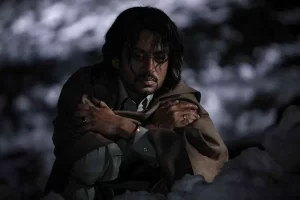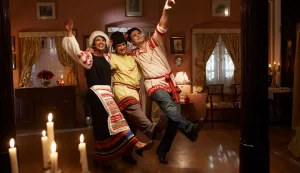Gothicism is a difficult genre to come by in the mainstream Hindi-film industry, finding a well made movie of that niche is far more rare. In this piece, I will be outlining the seven reasons why Vishal Bhardwaj’s 7 Khoon Maaf (7 Murders Forgiven), inspired by the Ruskin Bond novel, Susanna’s Seven Husbands, hits the genre on the nail.
The Anti-Hero
At the mention of a gothic heroine, the characteristic image of an otherworldly attractive and wealthy woman who has had to endure a number of misfortunes is evoked. Susanna Anna-Marie Johannes (Pryianka Chopra Jonas), the protagonist, certainly ascribes to all three of these conventions.
The femme fatale’s beauty entraps her victim’s who often use her for her riches and the untimely deaths of her parents mark the first two adversities of her life. However, despite the clear affliction of her orphan-hood which left Susanna “udaas” (sad) and “akeli” (lonely), she makes death a reoccurring event in her life. This is foreshadowed within the first ten minutes of the film by the narrator, Arun Kumar (Vivaan Shah). His statement that black, the colour of mourning, grief, funerals and death, “waqt ke saath…unka rang bangaya” (with time, became her colour) elucidates that she will be the culprit of the seven murders mentioned in the title.
This holds to be true and it is the homicides she plans with her band of three, Maggie (Usha Uthup), Goonga (Shashi Malviya) and Ghalib (Harish Khanna), that display her most obvious villain-like characteristics. However, each of her murders are coupled with the reasons of trying to escape various forms of abuse at the hands of her husbands and also to seek retribution against their wrongs. Hence, despite the magnitude of Susanna’s seven evil acts, she cannot be called the villain of the film, making her an anti-heroine.

Religious Concerns
Catholicism plays an active role in gothic stories and this may be due to the generally anti-Catholic political mindset that was occurring particularly in England during the emergence of this genre. 7 Khoon Maaf personifies the seven deadly sins, also called the seven capital/cardinal sins, of Roman Catholic Theology, through each of Susanna’s victims.
Pride — Her first husband and hence her first murder, Major Edwin Rodriguez (Neil Nitin Mukesh), represents Pride; the sin of believing superiority in oneself. The major depicts this most severely when he blinds Goonga during a duel, picking on a weaker component in an attempt to reassert his masculinity and power. The serious injury to her loyal servant was enough reason for the heroine to end Edwin’s life.
Sloth — Susanna’s second husband Jamshed Singh Rathod “Jimmy” (John Abraham), embodies sloth. Sloth refers to the failure to employ one’s talents and after all Jimmy does steal other artists compositions to become a successful singer. This time Susanna had a “rishta bachane ki zid” (stubbornness to save her marriage) so after discovering the fraudulent and cheating actions of her second husband, she persisted, buying the music he stole and trying to get help for his drug addiction. Clearly, she wasn’t stubborn enough because at the discovery that Jimmy did not remain sober, she decided to commit her second murder.

Wrath — Husband number three, the poet Wasiullah Khan (Irrfan Khan) is wrath, which is the feeling of overwhelming hate and anger towards another. His wrath appears in his physical abuse which in its own depraved way was the only thing that got the poet aroused. It is during this marriage that Susanna’s servants (Maggie, Goonga and Ghalib) are first seen as actively participating in the homicide.
Envy — Nikolai Vronsky (Alexander Diachenko) represents envy; the intense desire to possess what another has. Susanna’s dialogue at the beginning of her courtship with the foreigner, “you are jealous of Russians” basically spells this out and foreshadows how the reason for her third murder is rather because of her own feelings, than those of her fourth husband. At the discovery of his life with another wife and children in Russia, she ends her jealousy by ending him.

Lust — Susanna finds it difficult to escape authorities with the murder of her fourth husband so she fulfills the desires of the officer handling the case as a sort of bribe. The fifth husband, Keemat Laal (Annu Kapoor), embodies the sin of lust; a strong longing for sexual gratification. The murderess had only intended her favour to be a once off thing, but Keemat’s sexual desires could never be satisfied. Hence, in order to break free from the man, but still maintain her innocent status, she had to commit yet another homicide.
Greed — Dr. Modhusudhon Tarafdhar (Naseeruddin Shah) the sixth husband is Greed, which is the excessive desire for materialistic goods. Perhaps in an attempt to get an inheritance, the doctor tries to play the heroine’s own game against her, but fails and is brutally killed in a game of Russian Roulette.
Gluttony — Susanna’s seventh murder was not that of another husband, but rather her own metaphorical death. She represents the final sin of gluttony. Often associated with the overconsumption of food and drink, however it can also refer to selfishness and not considering how one’s actions can affect another. When Susanna fakes her death to escape authorities, her old-self, the one that would inflict pain upon others without hesitation, is killed.

Myths and Legends
The Faustian Bargain is a literary concept originating from the German legend of Johann Georg Faust, a highly intelligent and accomplished, yet dissatisfied man who makes a pact with the Devil to sell his soul for unlimited knowledge and power.
The bargain can be witnessed in a number of Gothic stories, The Picture of Dorian Gray by Oscar Wilde being a great example.
In this novel, the main character realises his beauty after seeing a portrait of himself and begs that age and ugliness does not appear on his face, but on the painting, a wish that is fulfilled. Susanna does seem to have a sort of Faustian pact given that despite her horrific crimes she remains not convicted of them. In fact, as the title says ‘Maaf,’ she is forgiven of what she has done.

However, unlike Faust her pact is not with the devil, but with Jesus. Throughout the film the protagonist speaks of Jesus in endearing terms and even attempts to form a closer connection with him, traveling to Kashmir where he supposedly lived his last days. The dialogue “wo mujhe mere gunnahon…ke saath apna raha hai” (he has accepted me with my sins) suggests a close personal relationship between Susanna and the son of God.
Susanna solidifies this relationship with a seventh marriage. Entering the order of nuns, she marries Jesus in a ceremony vowing servitude and even wearing a wedding ring. Their connection is most blatant in the penultimate scene which depicts her and Jesus dancing in the Sufi style of Semazen as they relive her murders with the song lyrics “tum chup rahe te ho” (you remain quiet) playing in the background.
Perhaps it was Jesus choosing to not speak up that kept her free of consequences and the ring in the wedding-like ceremony to become a nun, the symbolic representation of her Faustian Bargain.
Emphasis on Nature
Nature is a reoccurring element of Gothicism often depicting itself within the setting and topography to underscore the emotions of horror and gloom.
In Vishal Bhardwaj’s 7 Khoon Maaf fauna and flora are a powerful device used by the characters to bring about death. This is seen in the first murder where Major Edwin Rodriguez is pushed by Susanna towards a “man eating panther.”
The second time nature serves as a lethal tool, is for husband number four, Nikolai Vronsky, who is coerced to climb into a well, that the audience has already been made aware, is full of Susanna’s poisonous “paltu” (pets) — snakes.
The final time, flora as a opposed to dangerous animals is used to kill, however it is Dr. Modhusudhon Tarafdhar an expert of allopathy and naturopathy that concocts a fatal mushroom soup. Though Susanna escapes this threat to her life, her servant Ghalib falls prey to the seemingly innocent lunch and for the first time an unintended death takes place.

The Gothic Double
The Gothic Double explores the concept of doppelgängers and duality. In ‘The Picture of Dorian Gray’ Dorian and the realistic portrait of himself is an example of the double. In Matt Reeves’ 2022 take on the iconic superhero, Bruce Wayne and Batman serve as a duality in the characters personality. In 7 Khoon Maaf Susanna takes this a step further and instead of having one persona she creates seven.
In her first and sixth marriage she remains Susanna, in her second she becomes Jimmy’s Suzie even changing her attire, wearing leather jackets and skirts to reflect her rock-star husband. For her third she opts for the Urdu name Sultana and seemingly converts to Islam, given her adoption of the hijab, in order to match the Urdu poetry and religious beliefs of her lover. In her fourth marriage to the Russian Nikolai Vronsky, Susanna shortens to Anna, a reflection of the Russian classic ‘Anna karenina.’
Then she transforms to Sunaina in her fifth marriage. The femme fatale’s sixth personage, Saheb, is the one regarded by her servants and her seventh identity is born when she becomes a nun. Just as the vigilante Batman commits crimes he could not morally and literally get away with as Bruce Wayne and just as Dorian Gray’s immoral acts are projected as physical distortions on the painting instead and not him, Susanna creates this array of personalities so that she can flout social responsibilities and blame her transgressions on the double instead.
Explorations of Romance and Sexuality
Gothicism is a category of film and literature not afraid to depict the more shunned and risqué aspects of romance and sexuality. Having the excessive number of six husbands, the Rockstar Jimmy with his multiple affairs, the poet Wasiullah Khan’s demented arousal at the torture of his sexual partners and inspector Keemat Laal’s disregard of justice for the sake of sensual pleasures are all certainly instances of the genre’s flagrant representations of love and sex.
However, it is the reverse of the oedipal complex, a term coined by Sigmund Freud referring to sexual desires a child has towards a parent, that is the most confounding and disturbing relationship in 7 Khoon Maaf. Arun Kumar, the narrator of the film, is a boy hardly fifteen years younger than Susanna who financially adopts him, hence there is a sort of parent child relationship between them.
To Arun the opportunity of an education makes Saheb look like a God to him, however this image progressively deteriorates with her immoral acts and is finally annihilated when the heroine strips naked In front of a now adult Arun and attempt to seduce him, desiring more so company in her “akali” (lonely) life than sexual gratification.
The oedipal complex is clearly a line stepped too far across for Arun and so he doesn’t see the woman again for many years. Which brings me to the final gothic element of 7 Khoon Maaf — Revisiting the Past.

Revisiting the Past
The past plays a key role in Gothic films in the sense that it literally comes back to haunt the characters, either via more rational consequences or mystical ones of ghosts, curses and omens. In Vishal Bhardwaj’s 7 Khoon Maaf it is the former, where the inexplicable debts Arun owes to Susanna for providing him with an education, come back to haunt him where he has to mentally, later physically chooses to, revisit the place of his childhood that was full of Saheb’s dreadful deeds and perhaps for the first time, come to terms with them.
The film begins in the present and in media res, in the middle of the scene, leaving it at a cliff hanger until the narrator Arun recounts all the events leading up to it. Then finally returning to the present towards the last quarter only to conclude with Susanna returning to the past by confessing her sins.